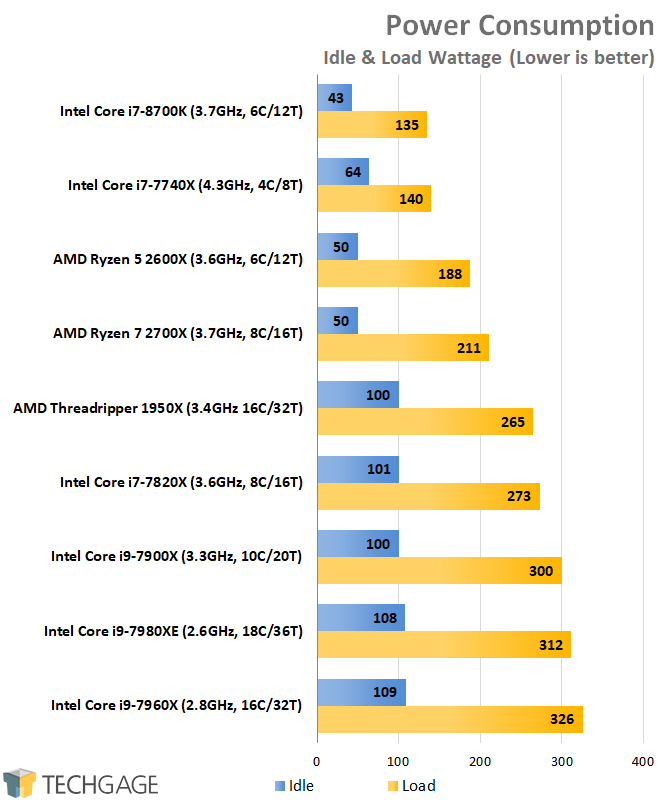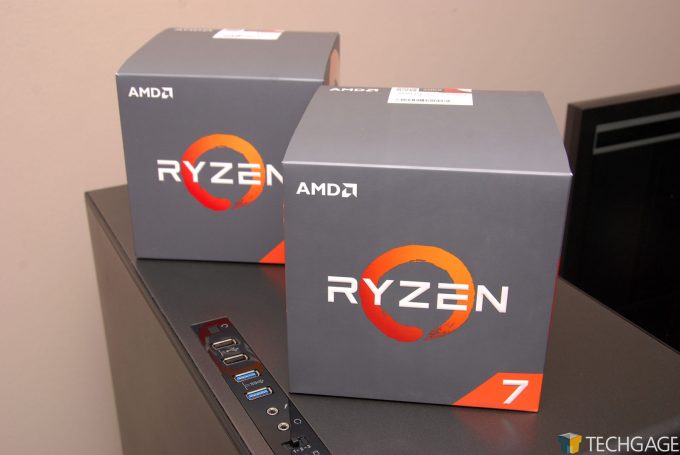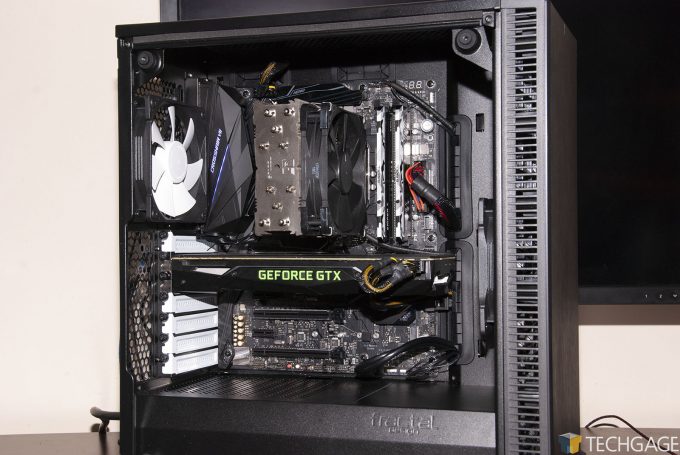- Qualcomm Launches Snapdragon 4 Gen 2 Mobile Platform
- AMD Launches Ryzen PRO 7000 Series Mobile & Desktop Platform
- Intel Launches Sleek Single-Slot Arc Pro A60 Workstation Graphics Card
- NVIDIA Announces Latest Ada Lovelace Additions: GeForce RTX 4060 Ti & RTX 4060
- Maxon Redshift With AMD Radeon GPU Rendering Support Now Available
A Performance Review: AMD’s Ryzen 5 2600X & Ryzen 7 2700X Processors

Following a deluge of leaks, AMD’s 2nd-gen Ryzen ‘Pinnacle Ridge’ CPUs have landed. These new ‘Zen+’ chips are built on a 12nm process, and bring in a brand-new chipset (even though the older chipset will work just fine!). Read on as we take a look at both the 8-core Ryzen 7 2700X, and 6-core Ryzen 5 2600X.
Page 8 – Power Consumption & Final Thoughts
To generate power-draw results for our collection of CPUs, we plug the test PC into a Kill-a-Watt for real-time monitoring, and stress the CPU with the help of our CLI-based HandBrake test (which can peak 100% of course in our tests). Idle power consumption is measured about 5 minutes after boot, once Windows decides to calm itself, and the wattage reading keeps stable.
Because AMD and Intel measure temperatures very differently, and there’s never a guarantee that software applications are reporting accurate readings, we forgo that testing. The only reliable method for capturing CPU temperatures is to go the hardware route, which is both very time-consuming, and expensive.
I will also add that HandBrake has recently been deemed a bit lacking to gauge the peak power draw, so with the next suite iteration, I’ll likely introduce something a bit more demanding. However, a video encode test which takes full advantage of the CPU is hardly a poor example of power draw, since it represents a typical demanding scenario.

With results all over the board like this, it’s hard to appreciate the real power efficiency differences between the platforms, but this still gives us a decent overall picture. Even with 4 sticks of DDR4 on the 8700K platform versus AMD’s 2, Intel delivers the best result here.
It’s hard to ignore the massive difference in idle draw between the X299 platform and the others. That platform is in fact beefier than the others (in terms of motherboard features), but a difference of 50W almost seems extreme. Nonetheless, what impresses me here is that a super-fast chip like the 2700X can operate at just over 200W. Some overclocked CPUs would require that much alone.
Final Thoughts
I admit that despite all of the testing I’ve been involved with the past few weeks, it feels like I rushed through Ryzen second-gen testing, and honestly, I’m surprised to be making the embargo lift. Beyond this point, I’m thinking I’ll probably wait for the Spectre dust to completely settle before continuing on with more testing. In particular, it might be smart to wait for the next Creators Update to land, which is apparently going to be happening very soon. With that build of the OS, I am hoping we can safely rebenchmark with the assurance that we won’t have to rebenchmark again a few weeks later.
That all aside, for as little time as I feel like I’ve spent with Ryzen 2, my initial thoughts are very good. Let’s be real, though: this is not a totally new product. It’s an iteration, so if you’re familiar with recent Ryzen experiences, this second-gen lineup is not going to introduce any surprises. Again, it’s an iteration, but a good one.
I’ll bring back an example I made earlier. Last year, the 8-core 1800X cost $499. This year, the 8-core 2700X costs $319. That’s in comparison to Intel’s $339 6-core Coffee Lake-based 8700K. Across all of the benchmarks here, AMD and Intel traded blows, but ultimately, AMD can usually dominate better than Intel can, thanks to its extra horsepower.
I sound like a broken record at this point, I’m sure, but I really do love Ryzen as a workstation chip. For the “ultimate” in performance, especially when we’re talking about every minor interaction done with a PC, the higher IPC of Intel is going to deliver the better performance. But if you’re willing to accept that caveat (one that you may not even notice, admittedly), you can gain handsomely when it comes to engaging in actually demanding scenarios, like video encoding, rendering, et cetera.
In 3ds Max, for example, the 2700X came well ahead of the 8700K, and the 2600X didn’t lag far behind. The same was repeated for Blender, Cinebench, V-Ray, and POV-Ray. Things change a bit in some media tests; Intel dominates Adobe Lightroom and x265 encodes, but again, AMD’s extra brawn does help it tighten the gap a little bit in those cases.
For gaming, Ryzen’s second-generation still leaves a bit to be desired. At 1080p, the differences remain noticeable for the most part, whereas at higher resolutions, like 4K, the differences are largely nonexistent between any one of the CPUs (except those that have strange performance in some cases, like Threadripper with WARHAMMER II).
The compromises people need to make with the second-gen Ryzen remain unchanged from the first. Slightly weaker gaming performance, lacking performance in certain areas where Intel tends to dominate (eg: media), but better performance overall in any scenario that simply requires more raw horsepower.
To that end, I personally couldn’t imagine choosing the 8700K over the 2700X if I’m a workstation user. I’m not a designer, but I benchmark enough 3D projects to feel like one, and it’s obvious the kinds of performance gains extra cores can make. As a hardcore gamer, I’d go Intel, because while higher resolutions seem to stabilize performance, Intel is still clearly dominant in this space, and gives the assurance that you’re going to get the best gaming performance across the board.
By now, you probably know enough about this chip, and admittedly, you probably knew enough before reading. Whereas the first-gen Ryzen launch was undeniably rough with regards to desperately needed updates that came out continually, I haven’t experienced any real issue with Ryzen second-gen to speak of, outside of the one where my Corsair 3200MHz kit wouldn’t run as a kit of four (even though it did on Threadripper). What that tells us is that you don’t want to haphazardly choose your memory kit for Ryzen – go with something that’s known to work well.
And with that, hopefully by now you know whether or not Ryzen’s second-gen is for you. If one of your questions hasn’t been answered, or you simply want to leave your two cents, please leave a comment.
Support our efforts! With ad revenue at an all-time low for written websites, we're relying more than ever on reader support to help us continue putting so much effort into this type of content. You can support us by becoming a Patron, or by using our Amazon shopping affiliate links listed through our articles. Thanks for your support!







